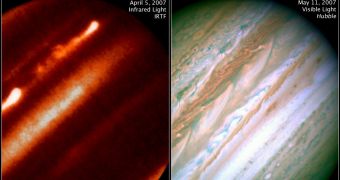In March 2007 Jupiter spawned a new gigantic atmospheric storm measuring an area of the size of two Earth continents. However, the thick Jovian atmosphere makes the observation of processes which take place inside it very difficult, disabling a good understanding of meteorological phenomenons which trigger these storms. A team of astronomers form Universidad del Pa?s Vasco led by Agust?n S?nchez-Lavega found that, in fact, Jupiter's atmosphere, similarly to our own, is powered by heat generated deep inside it.
On Earth for example, large storms usually occur in locations where the atmosphere is dominated by powerful jet streams which drive the air circulation. New observations conducted on Jupiter with the help of the Hubble Space Telescope and the Infrared Telescope Facility in Hawaii revealed that the bright material observed in the storm systems comes from deep within the atmosphere, moving in a ascendant motion to refresh the ammonia and water mixture in the top layers.
The jets of matter are powerful enough to move more that 30 kilometers above the visible top cloud of Jupiter's atmosphere, and create storms traveling at speeds of about 600 kilometers per hour. Theoretical models suggest that the ammonia and water jets originate at about 100 kilometers below the visible cloud top of the planet, where most of the sunlight received had already been absorbed in the atmosphere.
Jupiter has the wildest weather in the solar system. Just to give you an idea of the scale of the storms that take place on Jupiter, consider this: its Great Red Spot is known to rage through its atmosphere for more than 340 years, it is capable of rising more than 8 kilometers above the surrounding cloud tops, has winds exceeding 430 kilometers per hour, and a diameter large enough to swallow the whole Earth.

 14 DAY TRIAL //
14 DAY TRIAL //